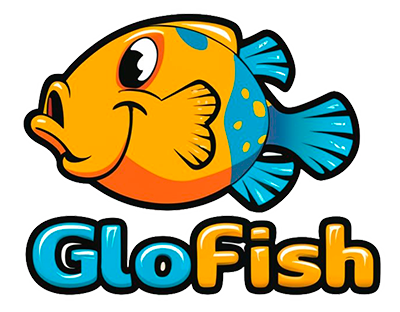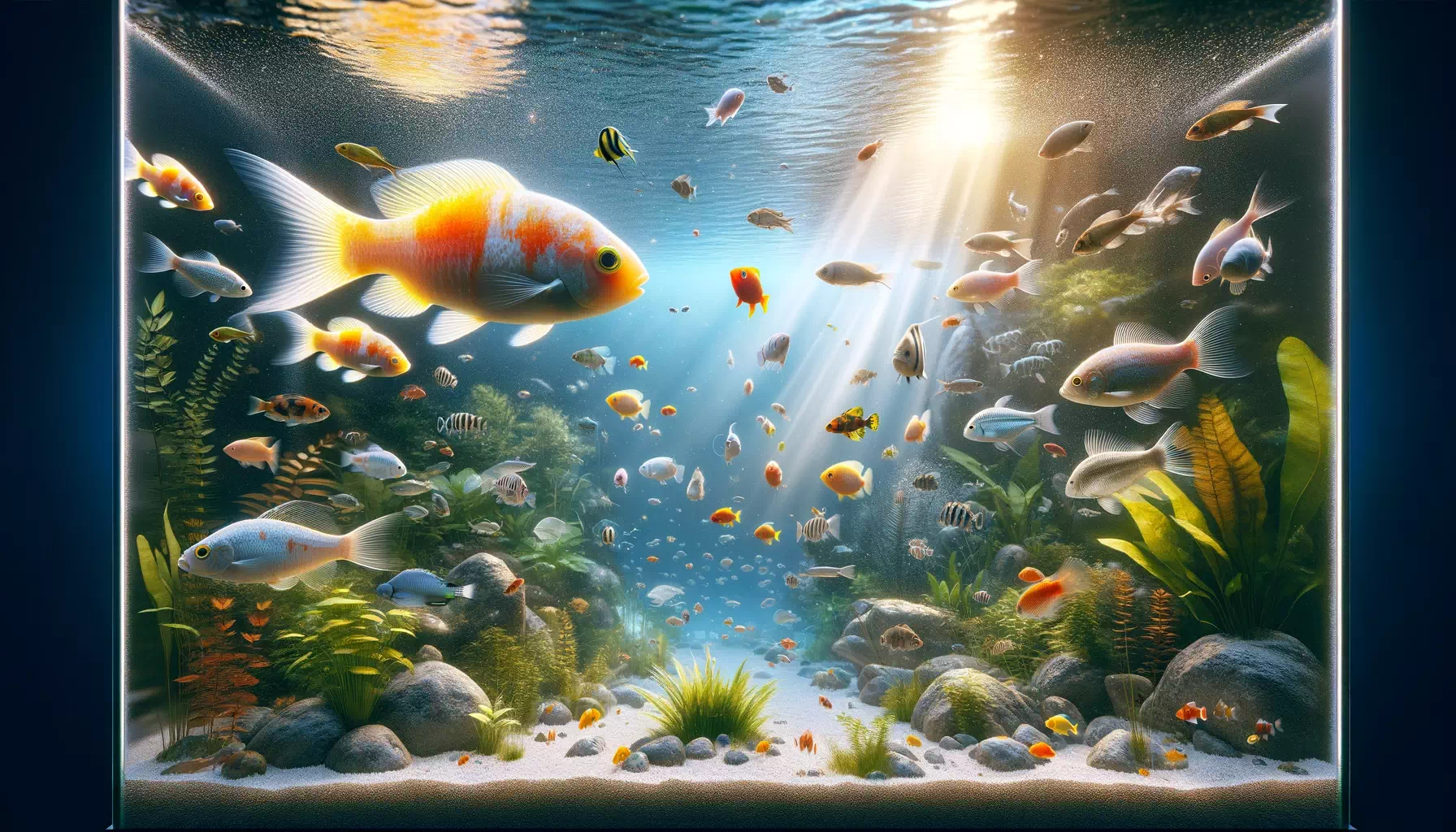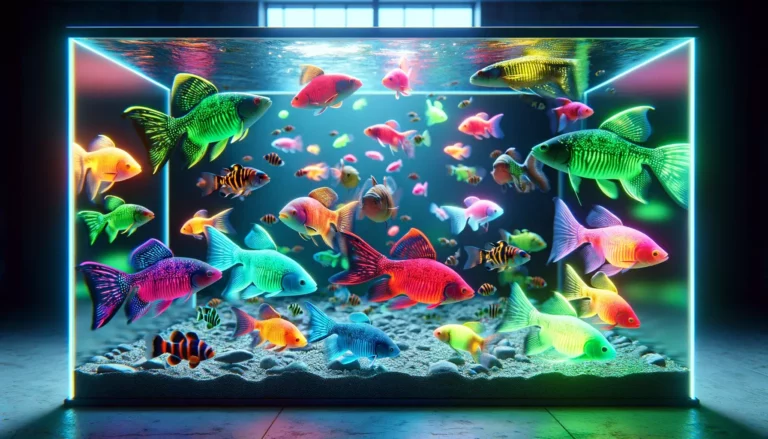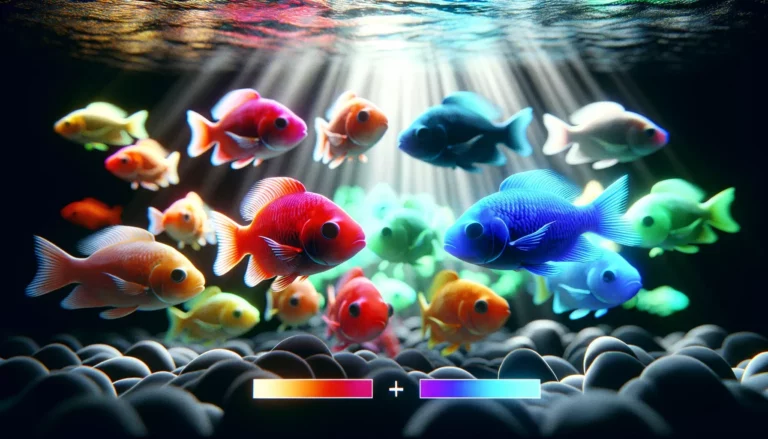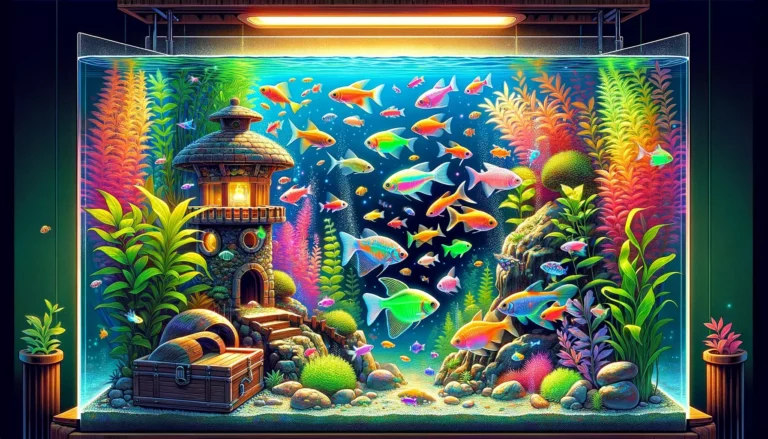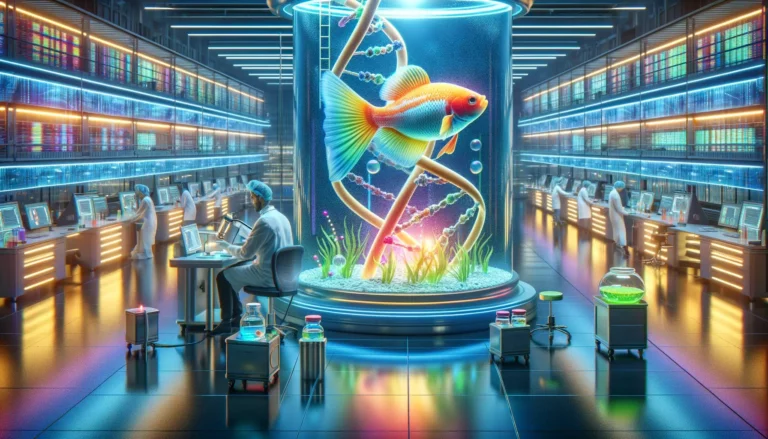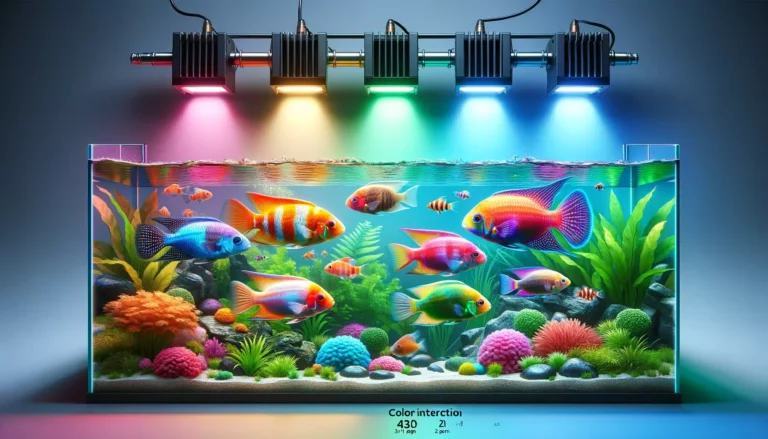Types of GloFish for beginner aquarists
GloFish come in various species, each with unique care needs. The most common types include Danios, Tetras, and Barbs. Danios are hardy and ideal for beginners. They thrive in temperatures between 72°F and 82°F. Tetras prefer slightly warmer waters, around 75°F to 80°F. Barbs need similar conditions but are more sensitive to changes.
pH levels also vary slightly. Danios and Tetras do best in a pH range of 6.5 to 7.5. Barbs, however, prefer a bit more alkaline environment, around 7.0 to 7.8. Tank environment is crucial too. All GloFish enjoy a planted tank but require different space. Danios are active swimmers and need more room.
For all species, clean, well-filtered water is a must. Regular water changes help keep their environment healthy. Beginners should test water parameters regularly. This ensures the fish live in optimal conditions.
Comparative Lifespan of Various GloFish Species
When choosing a GloFish, consider its lifespan. Danios, for instance, can live up to 5 years. This makes them a long-term commitment. Tetras have a slightly shorter lifespan, usually around 3 to 4 years. Barbs, under good care, can live up to 4 years.
The lifespan of these fish depends on care. Proper tank conditions, diet, and stress levels play big roles. Regular maintenance and monitoring can extend their lives. This is important for beginners to understand.
A well-maintained tank mimics natural habitats. This reduces stress and promotes health. Good nutrition also contributes to longevity. A balanced diet is key for all GloFish species.
Common Health Issues and Prevention in GloFish
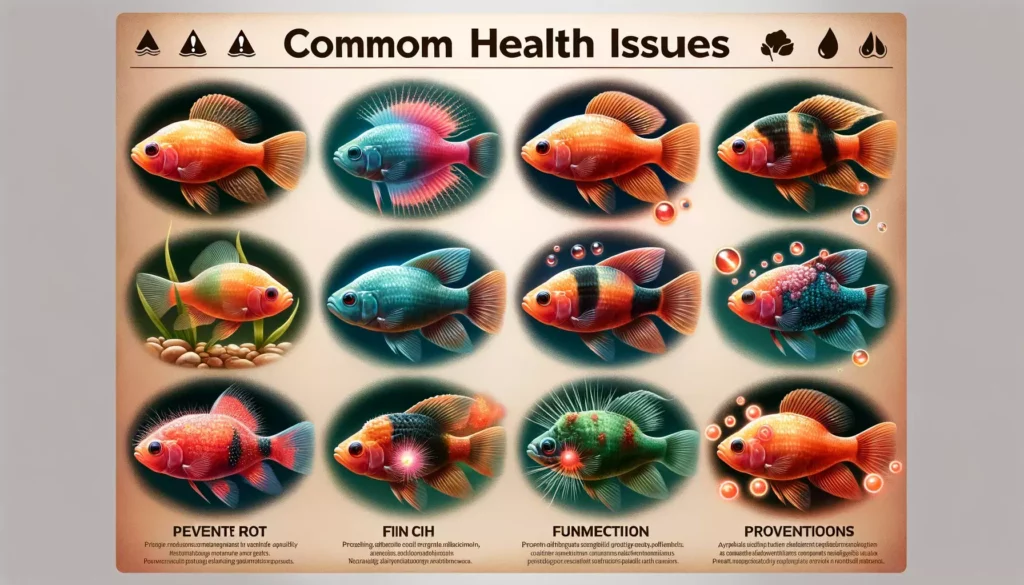
GloFish, like all aquarium fish, face health challenges. Common issues include fin rot, ich, and fungal infections. Fin rot is a bacterial infection, noticeable by frayed fins. Ich appears as white spots on the body and fins. Fungal infections manifest as white fluffy growths.
Prevention is better than cure. Maintain clean, stable water conditions to prevent diseases. Regular water changes and proper filtration are crucial. Avoid overfeeding as it pollutes the water.
Quarantine new fish before adding them to the tank. This prevents the spread of diseases. Observe your GloFish regularly for any signs of illness. Early detection leads to better outcomes.
In case of illness, isolate the affected fish. Treat with appropriate medications as soon as possible. Consult a vet or experienced aquarist if unsure about treatment.
Interaction of GloFish with Other Aquarium Species
GloFish are generally peaceful and can coexist with many species. However, their tank mates should be chosen carefully. Small, non-aggressive fish are usually the best companions. Examples include Corydoras, small Plecos, and some types of Guppies. Avoid larger, aggressive fish like Cichlids or Oscars. They can harm GloFish.
| Aspect | Guidelines and Considerations |
|---|---|
| Choosing Tank Mates | – Select small, non-aggressive fish as companions for GloFish. |
| – Examples include Corydoras, small Plecos, and some types of Guppies. | |
| – Avoid larger, aggressive fish like Cichlids or Oscars. | |
| Matching Water Parameters | – Choose fish that require similar water conditions to GloFish. |
| Overcrowding | – Avoid overcrowding the tank, as it can lead to stress and aggression. |
| Schooling Fish | – Keep schooling fish like Tetras and Danios in groups to reduce stress and aggression. |
| – Be cautious with Barbs, as they can be nippy; choose their companions carefully. | |
| Monitoring Interactions | – Monitor the interactions of different species when introduced to the tank. |
| – Be prepared to intervene if aggression or stress occurs. | |
| Providing Hiding Spaces | – Creating hiding spots can reduce stress and aggression among tank mates. |
| Overall Harmony | – A harmonious tank with compatible species promotes a healthy environment. |
It’s also important to match water parameters. Fish that require similar conditions make better tank mates. Overcrowding should be avoided. It stresses fish and leads to aggression.
Schooling fish like Tetras and Danios prefer groups. Keeping them in groups reduces stress and aggression. Barbs can be nippy, so choose their companions with care. A harmonious tank is a healthy tank.
When introducing new species, monitor their interactions. Adjustments may be necessary to maintain peace. An aquarist should always be ready to intervene if needed. Creating hiding spaces can also reduce stress and aggression.
Ethical Considerations in GloFish Aquaculture
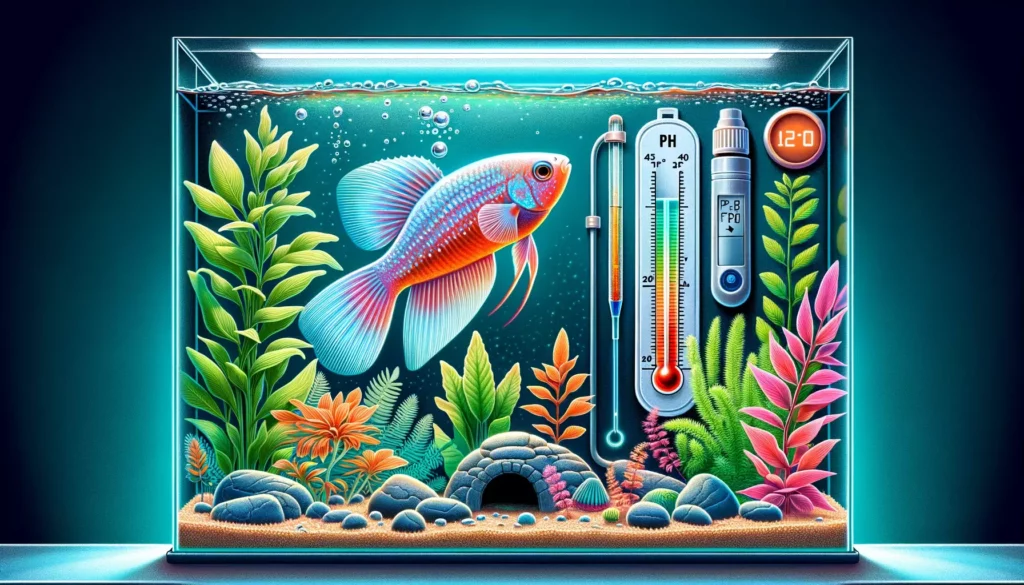
The creation of GloFish raises ethical questions. Their genetic modification for aesthetic purposes is a primary concern. Supporters argue that GloFish are safe and similar to traditional breeding. Critics, however, raise concerns about animal welfare and ecological impacts.
The modification does not harm the fish themselves. But the ethics of modifying animals for human enjoyment is debated. GloFish are banned in some regions due to these concerns. Prospective owners should consider their personal stance on this issue.
Environmental impact is another concern. If released into the wild, GloFish could affect native ecosystems. They are sterile to prevent breeding in natural waters. But the risk of ecological imbalance remains a topic of debate.
Ethics in pet ownership is complex. GloFish are no exception. Prospective owners should research and understand these issues. Responsible ownership and awareness are key.
Effective Tank Cycling Techniques for GloFish Beginners
Setting up a tank for GloFish involves understanding the nitrogen cycle. This cycle is crucial for maintaining a healthy aquatic environment. The cycle involves converting harmful ammonia to less toxic substances. This process is essential for fish health.
| Step | Description |
|---|---|
| 1. Set Up the Tank | – Add dechlorinated water to the tank. |
| – Ensure the tank is properly set up with substrate, filtration, and decor. | |
| 2. Add a Source of Ammonia | – Introduce ammonia to kickstart the nitrogen cycle. |
| – Options include fish food or a commercial ammonia source. | |
| 3. Regular Water Testing | – Use test kits to monitor ammonia, nitrite, and nitrate levels. |
| 4. Monitor Nitrite Levels | – The presence of nitrite indicates the cycle’s progress. |
| – Beneficial bacteria will convert nitrites to nitrates. | |
| 5. Keep Nitrates Low | – Regular water changes are needed to maintain low nitrate levels. |
| 6. Be Patient | – The cycling process can take several weeks to complete. |
| – Avoid adding fish before the cycle is finished to prevent harm. | |
| 7. Gradually Add GloFish | – After the cycle is complete, introduce GloFish slowly to not overwhelm the bacteria. |
| 8. Maintain and Monitor Regularly | – Consistent maintenance and monitoring ensure a stable, healthy environment for GloFish. |
Begin with setting up the tank and adding dechlorinated water. Add a source of ammonia to start the cycle. This can be fish food or a commercial ammonia source. Test the water regularly to monitor ammonia, nitrite, and nitrate levels.
The presence of nitrite indicates the cycle is progressing. Once nitrite levels rise, beneficial bacteria will convert them to nitrates. Nitrates are less harmful but should be kept low through regular water changes.
The cycle can take several weeks to complete. Patience is key. Adding fish before the cycle is complete can be harmful. Test kits are essential for monitoring the cycle’s progress.
Once the cycle is complete, add GloFish gradually. This prevents overwhelming the newly established bacterial colony. Regular maintenance and monitoring ensure a stable, healthy environment.
Optimal Feeding Practices for GloFish

Feeding GloFish correctly is vital for their health. The key is a balanced diet and controlled portions. GloFish, like Danios, Tetras, and Barbs, are omnivores. They need both plant and animal-based foods. High-quality flake food is a good staple. Supplement this with frozen or live foods like brine shrimp or bloodworms.
Feed small amounts twice a day. Only give what they can consume in 3 minutes. Overfeeding leads to water pollution and health issues. Watch their feeding behavior. Adjust amounts if necessary.
Vary their diet for nutritional balance. This keeps GloFish healthy and vibrant. Specialized GloFish food, with more color enhancers, is available. But it’s not a necessity. Regular fish food is adequate.
Avoid leaving uneaten food in the tank. It decomposes and affects water quality. Consistency in feeding times helps regulate their digestive systems. Good feeding practices contribute significantly to their overall well-being.
Impact of Tank Size and Decoration on GloFish Well-Being
The tank size and decoration play a crucial role in GloFish welfare. Adequate space and a stimulating environment are essential. Small tanks lead to stress and health problems. Each GloFish species has minimum tank size requirements. Danios need at least a 10-gallon tank, as they are active swimmers. Tetras and Barbs do well in similar-sized tanks but with more plants.
| Aspect | Impact on GloFish Well-Being |
|---|---|
| Tank Size | – Small tanks lead to stress and health problems |
| – Each GloFish species has minimum tank size requirements: | |
| – Danios: At least a 10-gallon tank | |
| – Tetras and Barbs: Similar-sized tanks with more plants | |
| Decoration and Plants | – Provide hiding spots and reduce stress |
| – GloFish enjoy both live and artificial plants | |
| – Help maintain water quality | |
| – Mimic their natural habitat, promoting natural behaviors | |
| – Reduce aggression | |
| Tank Overcrowding | – Leads to stress, aggression, and disease |
| – A spacious, well-planned tank ensures healthier, happier fish | |
| Lighting | – Proper lighting enhances GloFish colors |
| – Lighting should mimic natural day and night cycles | |
| – Constant light is stressful for fish | |
| Balanced Setup | – Balance in tank setup and maintenance is key for well-being |
Decoration and plants provide hiding spots and reduce stress. GloFish enjoy both live and artificial plants. These also help maintain water quality. A well-decorated tank mimics their natural habitat. This promotes natural behaviors and reduces aggression.
Avoid overcrowded tanks. This leads to stress, aggression, and disease. A spacious, well-planned tank ensures healthier, happier fish. Include space for swimming and exploration.
Proper lighting enhances GloFish colors. But it should mimic natural day and night cycles. Constant light is stressful for fish. Balance in tank setup and maintenance is key for their well-being.
Breeding GloFish in Home Aquariums: Management and Techniques
Breeding GloFish can be a fascinating experience, but it requires specific conditions. Each species has unique breeding requirements. Danios, for instance, scatter their eggs and don’t provide parental care. To breed them, separate a group into a breeding tank with fine-leaved plants or a breeding mat. After spawning, remove the adults to prevent them from eating the eggs.
Tetras and Barbs also need separate breeding tanks. These species prefer softer water and a lower pH for breeding. Mimicking rainy season conditions can encourage spawning. Like Danios, Tetras and Barbs may eat their eggs, so timely removal is necessary.
Maintaining the right temperature and water quality is crucial. A stable, clean environment supports egg development. Regular water changes and monitoring are essential during this process.
It’s important to note that breeding GloFish is subject to legal restrictions. Most GloFish are patented and their unauthorized breeding is prohibited. Always check local regulations and patent laws before attempting to breed GloFish.
Legal Restrictions on Keeping GloFish in Different Regions
When considering GloFish, it’s crucial to understand the legal aspect. The legality of keeping genetically modified organisms, including GloFish, varies across regions. In the United States, GloFish are legal in all states except California. California requires a special permit for genetically modified organisms.
In Europe, the regulations can be stricter. Many countries regulate or ban the sale of genetically modified animals. It’s important for potential GloFish owners to research their local laws.
The regulations are in place for ethical and environmental reasons. Concerns about genetic modification and potential ecological impacts drive these laws. Unauthorized breeding of GloFish can also be illegal due to patent laws.
Prospective GloFish owners should always research and comply with local regulations. This ensures responsible and legal pet ownership. Understanding these legal aspects is crucial before making a GloFish purchase.
